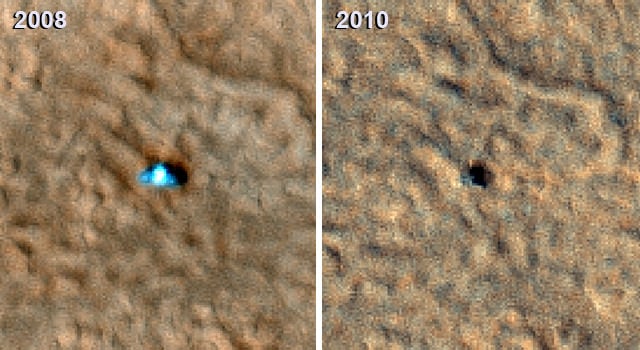[/caption]
The Phoenix lander will not be phoning home. A new image of Phoenix taken this month by the HiRISE camera (High Resolution Imaging Science Experiment) on board the Mars Reconnaissance Orbiter shows signs of severe ice damage to the lander's solar panels, with one panel appearing to be completely gone. The Phoenix team says this is consistent with predictions of how Phoenix could be damaged by harsh winter conditions. It was anticipated that the weight of a carbon-dioxide ice buildup could bend or break the solar panels.
"Before and after images are dramatically different," said Michael Mellon of the University of Colorado in Boulder, a science team member for both Phoenix and HiRISE. "The lander looks smaller, and only a portion of the difference can be explained by accumulation of dust on the lander, which makes its surfaces less distinguishable from surrounding ground."
Mellon calculated hundreds of pounds of ice probably coated the lander in mid-winter. Several attempts to contact Phoenix during the past few months came up empty.
[caption id="attachment_64996" align="aligncenter" width="580" caption="Phoenix parachute and backshell from 2008 (left) and 2010. Credit: NASA/JPL/U of Arizona"]
[/caption] "We can see that the lander, heat shield, and backshell-plus-parachute are now covered by dust," said Mellon and Alfred McEwen
on the HiRISE website
, "so they lack the distinctive colors of the hardware or the surfaces where the pre-landing dust was disturbed. But if the lander is structurally intact, it should cast the same shadows. While that is indeed the case for the shadow cast by the backshell (which came to rest on its side), that does not appear to be the case for the lander."
See the larger image of all the various pieces of Phoenix on the HiRISE website.
So now, the Phoenix mission is officially over.
But during its mission on Mars, Phoenix confirmed and examined patches of the widespread deposits of underground water ice detected by Odyssey and identified a mineral called calcium carbonate that suggested occasional presence of thawed water. The lander also found soil chemistry with significant implications for life and observed falling snow. The mission's biggest surprise was the discovery of perchlorate, an oxidizing chemical on Earth that is food for some microbes and potentially toxic for others.
"We found that the soil above the ice can act like a sponge, with perchlorate scavenging water from the atmosphere and holding on to it," said Peter Smith, Phoenix principal investigator at the University of Arizona in Tucson. "You can have a thin film layer of water capable of being a habitable environment. A micro-world at the scale of grains of soil -- that's where the action is."
The perchlorate results are shaping subsequent astrobiology research, as scientists investigate the implications of its antifreeze properties and potential use as an energy source by microbes. Discovery of the ice in the uppermost soil by Odyssey pointed the way for Phoenix. More recently, the Mars Reconnaissance Orbiter detected numerous ice deposits in middle latitudes at greater depth using radar and exposed on the surface by fresh impact craters.
"Ice-rich environments are an even bigger part of the planet than we thought," Smith said. "Somewhere in that vast region there are going to be places that are more habitable than others."
For more info and a look back at Phoenix,
check out the Phoenix mission website.
Source:
NASA
 Universe Today
Universe Today
